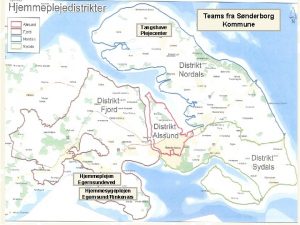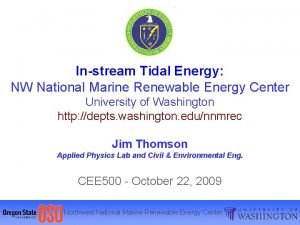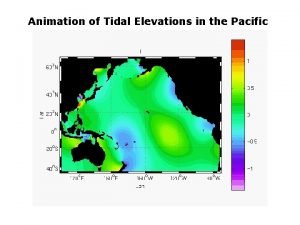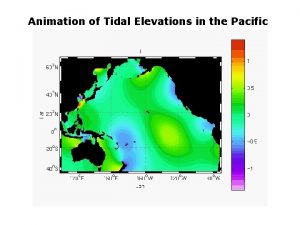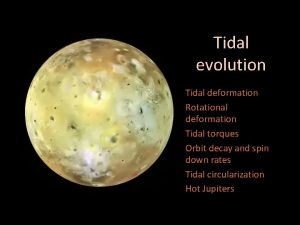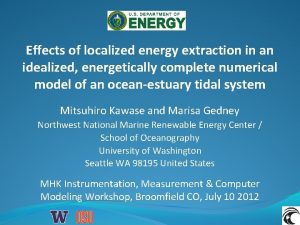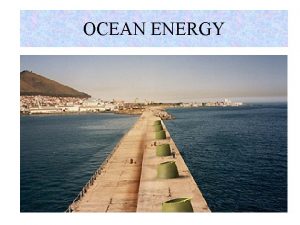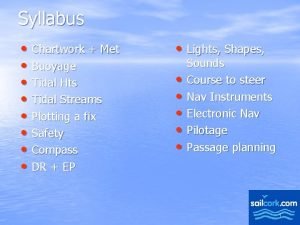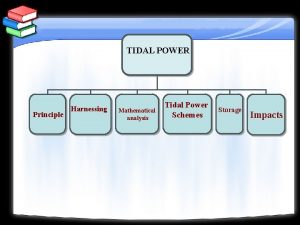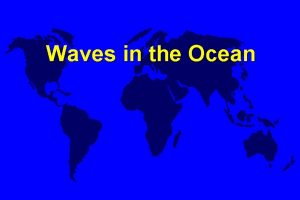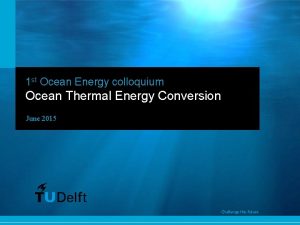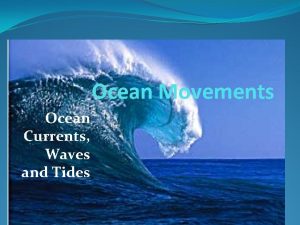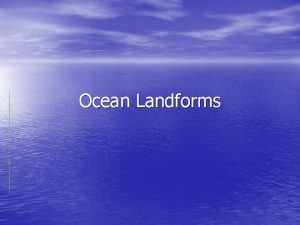Tidal Energy Extraction in an Idealized Ocean Fjord






















- Slides: 22

Tidal Energy Extraction in an Idealized Ocean. Fjord Tidal Model with Astronomical Forcing Mitsuhiro Kawase and Marisa Gedney Northwest National Marine Renewable Energy Center / School of Oceanography University of Washington Seattle WA 98195 United States EWTEC 2013, Aalborg, Denmark, September 2012

Acknowledgment �Funding for this project was provided by �U. S. Department of Energy Award Number DE-FG 3608 GO 18179 �Sandia National Laboratory

Contents �Introduction / Motivation �Model: Set-up, output and diagnosis �Energetics of tidal energy extraction �Subdomain model experiments �Summary / Take-home points

Tide is a Source of Energy for Oceanic and Coastal Processes: Munk and Wunsch (1998) Global Ocean Energy Schematic Divert to Tidal Energy Generation

Tidal energy is globally harvested from gravity of Regional hydrodynamic models receive sun and moon and transported by wave process: tides from boundary conditions, and are often heavily “tuned” to reproduce tides as observed. Kawase and Thyng, 2010 R. Ray, GSFC

Questions Addressed by This Study • How does tidal energy extraction look like in the context of regional / global tidal energetics? What useful things might we learn from such a perspective? • What are significant limitations (if any) of studying tidal energy extraction with a regional model? What are the uncertainties in energy extraction estimates made using regional models?

Approach: Construct an idealized numerical model of an ocean-estuary tidal system • Ocean with 4000 m-deep basin and 200 m-deep, 500 km-wide continental shelf • Tide is forced astronomically by tide-generating force (TGF, lunar tide, 20° declination) • 10 km-wide silled “fjord” is appended at the northeastern corner. • Normal case (200 km long) • Resonant case (400 km long) • Tidal energy is extracted over the sill (locally enhanced quadratic drag). • The model serves boundary conditions to subdomain models: • Regional model • Coastal model

Model Tidal Response: Non-resonant Fjord

Energy Balance Equation • For any model subdomain, Influx at the Boundary Natural Dissipation Energy Extraction CN = 0. 003 CE = Varied Gain from TGF

Energy Balance Equation • For equilibrium, average over tidal period, Influx at the Boundary Natural Dissipation Energy Extraction Gain from TGF

Energy Extraction and Tidal Range Change Energy Extraction MW meters Tidal Range Extraction Coeff. CE

Tidal Range (meters) Energy Extraction vs. Tidal Range Energy Extraction (MW)

Energetics of the Fjord: Non-resonant Case Energy Flux MW 274 MW 163 MW W/m 2 Natural Dissipation Change in Ocean Energy Flux

Mechanical Energy Flux Feeding Energy Extraction r There is no clearly defined outer boundary to the region from which the extracted energy is drawn – response to energy extraction is global.

Why should we care about reduction in natural dissipation due to tidal energy development? Simpson, et al. (1990) Entrainment of dense water by tidal stirring (Potential energy creation) Partially / Fully Mixed Estuaries • Always sufficient estuary length / kinetic energy available exchange insensitive to reduction in u. T? (Stommel and Farmer 1953; Mac. Cready and Geyer 2010) • However, other estuarine characteristics (e. g. salt intrusion length) might be strongly affected. (Simpson and Bowers 1981) Fjords • Exchange always limited by the amount of entrainment that can occur within a basin of fixed size (Knudsen 1900; Proudman 1953) exchange highly sensitive?

Energetics of the Fjord: Resonant Case MW Energy Flux 1. 57 GW 958 MW W/m 2 Natural Dissipation Change in Ocean Energy Flux

Subdomain Model Experiments

Subdomain Model Experiments Full Domain Model Subdomain Models Boundary condition Energy Extraction Experiments Intercomparison Energy Extraction Experiments

Energy Extraction vs. Tidal Range: Normalized

Energy Extraction vs. Tidal Range: Unscaled 298 MW 182 MW 247 MW 657 MW 562 MW 679 MW

Effect of Tide-Generating Force and Boundary Conditions on Maximum Extractable Energy Full Domain (MW) Regional Model (MW) Dirichlet, TGF CF CF, TGF 235 (-5%) Non-resonant 247 182 (-26%) 201 (-17%) 145 (-43%) Resonant 657 562 (-14%) 589 (-10%) 538 754 (-18%) (+15%) Coastal Model (MW) Dirichlet, TGF CF CF, TGF 298 296 246 (+21%) (+20%) (<+1%) 244 (+1%) 679 (+3%) 689 (+5%) CF = Chapman – Flather boundary condition 657 (0%) 698 (+6%)

Summary �Energy is extracted from a tidal estuary in part at the expense of natural energy flux into estuarine processes �Regional hydrodynamic models used for tidal energy applications should have its natural energetics validated �Limited-domain representation does not fundamentally change the physics of the energy extraction processes �Introduces uncertainty of up to ~25% in the carrying capacity of the estuary �With judicious choice of domain and boundary conditions, this could possibly be reduced down to ~10% (further research needed)
 Fjord terre neuve
Fjord terre neuve Fjord nastanek
Fjord nastanek Hjemmeplejen fjord
Hjemmeplejen fjord Negatives of tidal energy
Negatives of tidal energy Tidal energy ltd
Tidal energy ltd Tidal energy environmental impact
Tidal energy environmental impact Tidal energy pros and cons
Tidal energy pros and cons Tidal energy assignment
Tidal energy assignment Tidal energy pdf
Tidal energy pdf Tidal energy
Tidal energy Tidal energy
Tidal energy Tidal power animation
Tidal power animation Tidal energy animation
Tidal energy animation Divergent convergent and transform
Divergent convergent and transform Ocean ocean convergent boundary
Ocean ocean convergent boundary Convergent plate boundaries
Convergent plate boundaries Ocean ocean convergent boundary
Ocean ocean convergent boundary Nekton include all animals that
Nekton include all animals that Sciencechannel.com/activate
Sciencechannel.com/activate Convergent oceanic oceanic plate boundary
Convergent oceanic oceanic plate boundary Red ocean vs blue ocean
Red ocean vs blue ocean Steve jobs influence
Steve jobs influence Ideal and real self example
Ideal and real self example


